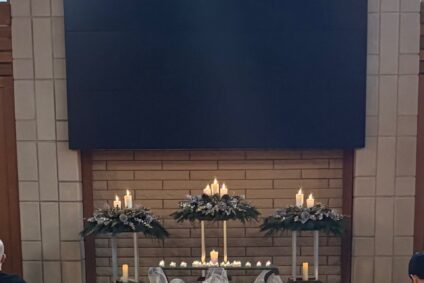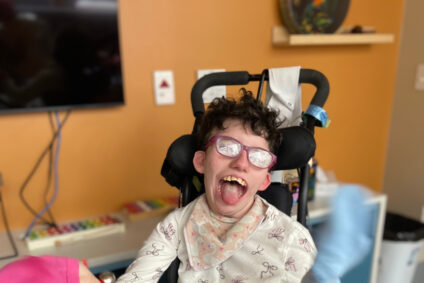Emily Yeskoo: One Year Reflection Written by Lindsey Yeskoo

I am seeing purple everywhere, as I venture out on walks through the neighbourhood while summer drifts into fall. It was Emily’s favourite colour. As her Mom, the memories of these days and nights one year ago are vivid, fresh inside me. You see, in the dark of night, hand in hand with the changing season, and from my own encompassing arms, she slipped away from us in the early morning of Tuesday, September 24th, 2019.
She was twenty-six years old.
In the early years when she was vibrant and healthy, moving in and out of different countries because of her Daddy’s job, learning different languages (like Japanese and Mandarin), and generally taking life by storm, people would ask her, “What do you want to be when you grow up?” She had one emphatic reply: “I want to be a teacher, an author, and an illustrator!”
No one had the least inkling how her life would unfold, or under what very unexpected circumstances her dreams would be fulfilled.
Within seconds, it seemed, after she reached her 8th birthday, something changed in her. All of a sudden, her usually undaunted zest for life was pierced by occasional fleeting dark looks across her face. For about 30-45 seconds, her eyes became fixed and she responded to nothing and no one, as if she also could not hear. Then she would immediately snap out of it and continue, as if nothing had happened. (These turned out to be petit mals seizures).
More changes began surfacing. Her handwriting, for example. Letters and numbers began to take the form of lightning. And she became increasingly unable to form thoughts or carry out mathematical problems, even simple ones. It was not long before she could no longer put pencil or pen to paper, and her tremendous talent in art completely crumbled. Her social skills suffered greatly, leaving her isolated. Then her motor skills took a dive. Running (she was on the soccer team), cycling, walking, then standing, all became precarious as we never knew when she might fall. And somehow, she also lost the capacity to protect herself. She could no longer function in school. … Her spirits were almost completely broken. Hanging by a thread. What was happening to her?
Our family was living in China at the time. We avidly (frantically!) sought help and support but the repeated and escalating symptom / band-aid, symptom / band-aid approach was not working. Finally, at the height of the SARS epidemic in March 2003, Emily and I were given orders to medically evacuate from Shanghai in order to be admitted straight away to hospital back in North America for extensive testing. The root of the problem needed to be discovered. We were required to leave behind her 5-year-old sister, her 11-year-old brother, and 43-year-old Dad.
The two of us were in the air for 17 hours and arrived at the hospital on a Monday night. On the Wednesday morning, just 36 hours later, the paediatric neurologist sat down with me, to gently relay the devastating findings. Emily was living with the juvenile onset of a rare and devastating neuro-degenerative disease called MLD: metachromatic leukodystrophy. I was told that she would lose all her capacities very quickly, developing similar symptoms as those in final stages of MS, ALS and Alzheimers. It was not known if she would live weeks, or months, but at the very most we might have three years left with her.
She was 10 years old at the time.
As you can imagine, this turned our lives upside down. She would need as stable and loving environment as possible, near excellent medical facilities. This meant an abrupt halt to our overseas lives. The other three members of the family packed up in the middle of the school year and headed back to join us.
Yes, the disease ravaged our Emily. Within one year after the diagnosis, she had lost all her capacities … except for her mind and her will and her longings and her indomitable spirit. The care she required from me at home from 2006 onwards became 24/7 and grew increasingly intense. This is where the Philip Aziz Centre for Hospice Care (PAC) stepped in, upon hearing of the need, and began sending amazing and exceptionally well-trained volunteers on a weekly basis to help fill in gaps. We shall forever be grateful! At that same time, CEO Rauni Salminen was aware of the distressing pressure on other families like ours in the community who were stretched to the limit, caring for children with life-limiting illnesses, while trying to keep their families together. What could be done to address these situations and assist in lightening the load? In due process, it was determined that Toronto desperately needed a paediatric hospice, closely connected to the Hospital for Sick Children, where respite could also be available in a beautiful, nurturing, home-like atmosphere, tended by skilled and caring professionals. Hence the birth of Emily’s House! It was the greatest honour of our Emily’s life, bringing her untold joy right up until the last moments of her life, that her name was chosen to represent all the other children and young people in the community who would find a welcoming place here. She was even present on an ambulance stretcher at the outdoor Ground-Breaking Ceremony for Emily’s House back on September 15th, 2011; and was ecstatic about being the first client to receive respite care there when the doors opened in the summer of 2013. As the years went on, she spent more time there but she also ended up receiving incredible visits at our home from its various supporting therapists who came to play and create and sing with her.
Emily came very close to the brink of death a number of times over her twenty-six years. It was quite a journey. Yet she lived twice as long as any medical prediction! In extraordinary ways, she who could no longer speak or write or communicate in any conventional manner ended up being our teacher on so many levels, especially about living life with tremendous grace in spite of having a body that could not co-operate as one might have wished. Her days and nights were documented and shared via journal format, widely distributed across the globe where pockets of caring people who had come to know her would wait eagerly for the next update. In the last two years of her life, she blew us all away by suddenly beginning to paint again, becoming Artiste Extraordinaire, leaving behind over 400 final expressions of her soul.
Near and far, Emily’s bedside, where she spent her remaining years at the centre of our humble home, became a very safe place for thousands of people. Her diagnosis never fully described or defined her; she lived far more expansively than that, on physical, mental, emotional, and spiritual levels. She had a viable, profound faith and a massive heart of love and forgiveness which she extended, over and over again. I was always able to speak to her on deep levels including that very last sacred night when it became necessary to lovingly help her make the passage from this life to the next. She knew that her life had meaning and purpose. The way she had lived all these extenuating circumstances and the dis-abilities of her life had inspired countless others.
I have no words for how much I miss her. That would also be true of her Dad, and her now 29-year-old brother and 23-year-old sister, as well as a very long trail of relatives and friends. The hole is gaping. But we are changed people, because of her and because of the quiet wisdom her life still imparts to us.
Let it be said: our love for her is even greater than our sorrow.


